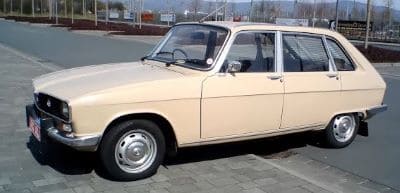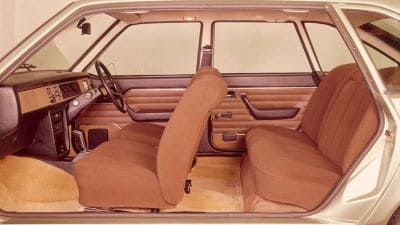UK 4x4 and SUVs ›› History of the Renault 16
History of the Renault 16
It may have been forgotten by many, but the 15 year history of the Renault 16 actually spans three decades from 1964 to 1980.
This article provides the ideal moment to reminisce about the Renault 16 (R16) family hatchback. It had a flexible, yet confusing, body style that somehow combined a saloon car with an estate.
The Story Begins with Success in Europe
The French automobile manufacturer Renault built several small cars back in the 1960s. Most noteworthy were the Renault 4 hatchback, the Dauphine, and the executive saloon called the Frégate.
The Renault 16 began its journey in August 1964 when the media saw the first official pictures of the new family hatchback.
Manufacturing took place at a purpose-built factory near Le Havre and the production of a right-hand drive version started in 1965.
It's fair to say the car sold well throughout the UK and most of Europe. It won praise for its practicality, as well as the comfortable and spacious interior that it offered.
Despite a rigorous marketing campaign in the United States, it failed to enjoy the same success. But, after setting up an assembly of Complete Knock-Down (CKD) kits in Canada, it fared better with their northerly neighbours. In fact, close to 2 million Renault 16s were produced during its 15 year reign.
Pro Tip: They made two specifications available to the public. Even so, the Grand Luxe and the Super were both powered by a 1470 cc engine.
Renault 16 Replaces the Ageing Frégate
When Renault considered the Frégate as being an outdated saloon, they drafted in Gaston Juchet (an industrial designer) to work on its replacement.
The initial plan was to build a large boxy vehicle with a six-cylinder engine. Instead, the CEO rejected it and they went for a new two-box hatchback for the Frégate's successor.
As outlandish as it may have seemed in the late sixties, the new family car had six (6) windows, a low waistline, and a tailgate.
But wait - there's more:
At the time, you might say that introducing the first family hatchback was a game-changer. Yet, the public were still trying to determine whether it was a saloon car, an estate, or a van.
Nevertheless, most of the appeal came from its "practical" capabilities. For example, sliding, folding, or removing the rear bench provided six layouts of flexible boot space.
 Plus, because the Renault 16 was a front-wheel drive model, it boosted the cabin and luggage space.
Plus, because the Renault 16 was a front-wheel drive model, it boosted the cabin and luggage space.
Renault 16 Crowned Car of the Year 1966
In fact, the Car of the Year award in 1966 saw the R16 beat the Rolls-Royce Silver Shadow (2nd place) and GM's luxury Oldsmobile Toronado in third place.
It would not be wrong to give further praise to most of the French cars manufactured during this period. However, excluding the Citroen DS, the Renault 16 offered an idiosyncratic ride akin to a magic carpet.
In 1967, they redesigned the dashboard and they made significant improvements to the heating and ventilation systems. The same year saw the inclusion of a choke valve that operated "automatically".
Introducing the Renault 16 TS
When Renault introduced the Tourisme Sportif (TS) in 1968, it had an inline-four 1565 cc engine that could reach 100 mph. It also had an all-new instrument panel that featured:
- A tachometer
- Water temperature gauge
- Two-speed windscreen wipers
- Rear defroster
- Passenger reading light
- Manual steel sunroof (optional)
The Australian assembly commenced in 1968, and they also started making a bespoke variant - marketed as the Sedan-Wagon - for the US market.
Renault's 16 Goes Upmarket
The family hatchback featured a new range of classy gadgets and accessories in 1969. It had leather upholstery inside the cabin, the new version sunroof was electric (as were the front windows), and it had reversing lights.
It also featured the first French-built automatic transmission gearbox, designated by a TA badge on the tailgate (an abbreviation for Transmission Automatique). Another one of the mild revamps took place in 1971. The most noteworthy changes included:
- New rectangular tail lights.
- The L and TL models replace the Grand Luxe and Super.
- Front seat belts became a standard feature.
- The discontinuation of the TS range.
1973 Renault 16 TX Model Arrives
They unveiled the upscaled TX top-line model in October 1973 at the Paris Motor Show. It had an enlarged 1647 cc engine and a 5-speed manual transmission.
Four rectangular headlights, and large turn signal lights below, helped to distinguish it from other models. The TX also featured:
 Gordini wheels (division of Renault Sport Technologies)
Gordini wheels (division of Renault Sport Technologies)- Rear windscreen wiper
- Rear spoiler
- Laminated windscreen (shatterproof)
- Automatic inertia reel seatbelts
- Power windows
- Central locking
- Air conditioning (optional)
- Sliding sunroof (optional)
Renault discontinued the L and TS models in the mid seventies. The replacements were eventually unveiled as the Renault R18 saloon and the Renault 20 and 30 models.
Renault 16 Production Ends January 1980
The simple reason why there are so few Renault 16s being driven on the roads today is rust (aka the dreaded tin worm). Thus, most of them had rusted away beyond normal repair by the mid 1980s.
In fact, according to historical records, less than seventy have survived in Britain. Plus, there may be a dozen or so "garage-finds" tucked away in some remote building awaiting renovation.
In case you were wondering:
The general price guide for buying a classic Renault 16 at a British car auction is about £3,000. You might grab a banger for about £400. But, be aware that car parts and spares may be difficult to source.
There's even a suggestion that the British Formula One driver Sir Stirling Moss was a fan of R16s, once saying:
"There is no doubt that the Renault 16 is the most intelligently engineered automobile I have ever encountered. I think each British motorcar manufacturer would do well to purchase one just to see how it is put together."
In point, it took many years for British car manufacturers to catch up. You could argue that the introduction of the Austin Maxi took on the role. But, it was a relatively unknown car outside of the British Isles.
Editor's Bio: We are self-confessed car fanatics and we enjoy writing blog articles about the automotive industry - especially here in the United Kingdom.
You might also enjoy reading about...
After discovering the range of Renault cars for sale in the United Kingdom it would be difficult not to find one that suits your lifestyle and budget. The section contains links to a range of Renault cars and SUV vehicles with further coverage of news items issued by the headquarters in Boulogne-Billancourt, France.